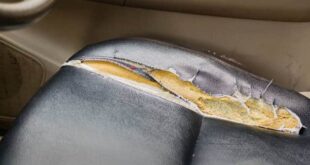Suspension Repair: A Guide to Keeping Your Ride Smooth. Maintaining vehicle‘s suspension system is crucial for ensuring a smooth, safe, and comfortable driving experience. The suspension system, which includes components like shocks, struts, and springs, plays a vital role in handling, stability, and overall driving comfort. This guide will provide you with an in-depth look at suspension repair, covering everything from understanding the system to diagnosing issues and performing repairs.
Understanding the Suspension System
The suspension system is responsible for keeping your vehicle’s tires in contact with the road while absorbing shocks and vibrations. Key components include:
- Shocks and Struts: These dampen the impact of road irregularities.
- Springs: They support the vehicle’s weight and absorb shocks.
- Control Arms: These connect the suspension to the vehicle’s chassis.
- Ball Joints: They allow for smooth movement between parts.
Common Suspension Problems
Identifying suspension issues early can prevent more serious problems down the road. Common signs of suspension problems include:
- Unusual Noise: Clunking or rattling noises when driving over bumps.
- Poor Handling: Difficulty steering or excessive sway.
- Uneven Tire Wear: Uneven tire tread can indicate alignment issues.
- Leaking Fluid: Visible oil or fluid leaks from shocks or struts.
Diagnosing Suspension Issues
Proper diagnosis is crucial for effective repair. Steps to diagnose suspension problems include:
- Visual Inspection: Check for visible damage or wear.
- Test Drive: Pay attention to how the vehicle handles.
- Check Fluid Levels: Inspect for leaks in shock absorbers.
- Examine Tires: Look for uneven wear patterns.
DIY Suspension Repair Tips
For those who prefer DIY repairs, here are some tips to guide you:
- Use Quality Parts: Always choose high-quality replacement parts.
- Follow Manufacturer Guidelines: Refer to your vehicle’s manual for specific instructions.
- Safety First: Ensure the vehicle is securely lifted before starting work.
- Proper Tools: Use the correct tools for each task to avoid damage.
- Torque Specifications: Follow proper torque settings for bolts and nuts.
- Alignment Check: Always check wheel alignment after suspension work.
- Professional Help: If unsure, consult with a professional mechanic.
- Regular Maintenance: Regularly inspect and maintain the suspension system.
- Clean Work Area: Keep your work area clean to avoid losing small parts.
- Test Thoroughly: After repairs, test drive the vehicle to ensure proper functioning.
When to Seek Professional Help
Certain situations warrant professional intervention:
- Complex Repairs: For major issues like strut replacement, professional help is recommended.
- Alignment Issues: Misalignment can affect safety and handling.
- Specialized Equipment: Some repairs require specialized tools and equipment.
- Safety Concerns: If you’re unsure about the repair, a professional should handle it.
Cost of Suspension Repairs
The cost of suspension repair can vary based on the extent of the damage and the vehicle model. Generally, expect to pay for:
- Labor Costs: Professional repair labor can be expensive.
- Parts Costs: Replacement parts vary in price.
- Alignment Costs: After repairs, wheel alignment may be necessary.
Preventive Measures
To avoid suspension issues:
- Regular Inspections: Have your suspension system checked regularly.
- Drive Carefully: Avoid potholes and rough roads when possible.
- Proper Load: Don’t overload your vehicle, as it can stress the suspension.
Tips for Maintaining Your Suspension System
- Routine Checks: Regularly inspect suspension components for wear and damage.
- Fluid Levels: Ensure shock absorber fluid levels are adequate.
- Drive Smoothly: Practice smooth driving to reduce stress on the suspension.
- Alignment: Maintain proper wheel alignment to avoid uneven wear.
- Replace Worn Parts: Replace parts that show signs of wear or damage promptly.
- Suspension Upgrades: Consider upgrading suspension components for better performance.
- Listen for Noises: Pay attention to any unusual noises during driving.
- Check for Leaks: Regularly check for fluid leaks from shocks or struts.
- Consult Experts: Seek professional advice for complex issues.
- Keep Records: Maintain records of all suspension-related repairs and maintenance.
FAQs about Suspension Repair
- What are the signs that my suspension needs repair?
- Unusual noises, poor handling, uneven tire wear, and leaking fluids are common indicators.
- How often should I have my suspension system inspected?
- It’s recommended to have it inspected every 12,000 miles or as specified in your vehicle’s manual.
- Can I drive with a damaged suspension?
- Driving with a damaged suspension is risky as it can affect handling and safety.
- What is the cost of suspension repair?
- Costs vary depending on the extent of the repair and the vehicle model.
- How long does a suspension repair take?
- It typically takes a few hours, but complex repairs may take longer.
- Can I replace suspension parts myself?
- Yes, but ensure you have the right tools and knowledge for the job.
- What should I do if I notice uneven tire wear?
- Uneven tire wear often indicates alignment issues; get it checked by a professional.
- How can I prevent suspension problems?
- Regular maintenance, careful driving, and prompt repairs can help prevent issues.
- Is professional help necessary for all suspension repairs?
- Major repairs and complex issues usually require professional assistance.
- What parts are commonly replaced during suspension repair?
- Commonly replaced parts include shocks, struts, control arms, and ball joints.
Conclusion
Proper suspension repair is essential for maintaining your vehicle’s performance, safety, and comfort. Regular inspections and timely repairs can prevent major issues and extend the life of your suspension system. By understanding the common problems, diagnosis methods, and repair tips, you can ensure a smoother and safer driving experience. Remember, when in doubt, consult a professional to address complex repairs and maintain optimal vehicle performance.
 oto car insurance used car repair
oto car insurance used car repair
